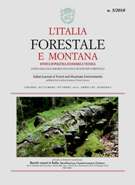Special section
DEADWOOD IN FOREST STANDS CLOSE TO OLD-GROWTHNESS UNDER MEDITERRANEAN CONDITIONS IN THE ITALIAN PENINSULA
Published 2013-05-16
Keywords
- unharvested Mediterranean forests,
- sustainable forest management,
- forest inventory,
- Italy
Copyright (c) 2013 Italian Journal of Forest and Mountain Environments

This work is licensed under a Creative Commons Attribution-NonCommercial 4.0 International License.
Abstract
Considering that indicators of old-growth features can vary across the European ecoregions, this paper provides some results to identify the distinctive traits of old-growthforests in the Mediterranean ecoregion. Deadwood occurrence as indicator of naturalness is investigated in some remote forest areas that have developed in absence of anthropogenic
disturbance over the past few decades. Eleven study sites across the Italian peninsula were selected and records of deadwood were carried out in 1-ha size plots. Deadwood volume, deadwood types and decay stages were inventoried in the selected sites. The amounts of deadwood indicate a large variability among the investigated forest stands: the total
volume ranged between 2 and 143 m3ha-1, with an average of 60 m3ha-1. Lying deadwood is the most abundant component of deadwood in the investigated forests, due to the
natural mortality occurring in the stands in relation to the processes established in the last
decades. On the contrary, stumps are the less represented type of deadwood in almost all the study areas. All the decay classes are present in each study site. The amount of deadwood in Southern Europe, even if lower than that reported for North and Central European countries, could have a different meaning due to the faster decay occurring in Mediterranean forest ecosystems. For this reason, old-growth features and the characteristics of each indicator should be framed and referred to well-defined climatic andbiogeographic contexts. Distinctively, under the conditions here investigated, three main deadwood features prove to characterize forest stands close to old-growthness: a ratio of dead to living wood not lower than 10%; lying deadwood much more abundant than the standing one; large range of deadwood size and decay classes across all the deadwood components.

